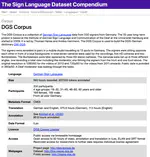
EASIER is a Horizon 2020 project that aims to design, develop, and validate a complete multilingual machine translation system that will act as a framework for barrier-free communication among deaf and hearing individuals, as well as provide a platform to support sign language content creation.
The project foresees a strong involvement of end-users in design, development, and evaluation of the EASIER ecosystem, where users of various European sign and spoken languages will be able to use their preferred language to interact with each other.
The project concept is based on a unique combination of technological sign language resources and sign language linguistics expertise. This allows for exploitation of a robust data-driven sign language recognition engine, the incorporation of a signing avatar that integrates sign language grammar and prosody features to perform the most advanced synthetic signing currently available, as well as the state-of-the-art machine translation technology that consumes both annotated and unannotated data to deal with a wide range of use scenarios.
Marc Schulder
Research Associate in Computational Linguistics
My research interests include sign languages, natural language processing, and open science.
Publications
Abstract
The Multilingual Sign Language Wordnet is the first publicly available wordnet resource for sign languages. It is a growing multilingual resource providing data for eight sign languages to date. During the initial phase of its creation, the focus lay on producing the infrastructure to support various languages and to produce initial sets of content for them. This article represents the start of the second phase, in which the focus is moved to establishing overlapping coverage across the different sign languages. Building on the data produced so far, a new feature to assist annotation is introduced which leverages established partial synonymy between signs (inter- and cross-lingually) to discover likely additional synonymies. Other improvements to the annotation interface and workflow build directly on the experiences from the first phase. Working with the updated annotation interface, new data is produced for Polish Sign Language, Greek Sign Language and Swedish Sign Language.
Abstract
The purpose of the interlingual index is to link the lexical resources of the sign languages of the project. This is the final project release of the index, which covers both the core sign languages of the project as well as additional sign languages.
Abstract
This report describes the EASIER Autumn School, a workshop held on 25–26 September 2023 in Hamburg. Titled “Sign language data meets data science – data science meets sign linguistics”, the workshop had the goal of generating expertise for under-resourced sign languages (SLs) to extend the scope of EASIER to more European SLs. The idea was to not only support people who already work with SLs and train them in technological approaches, but also to train people from data science, language technologies, etc. in the handling of SLs. Two parallel tracks introduced both groups to relevant topics of the other area, followed by a joint track addressing language technologies of the EASIER pipeline and ethical considerations.
Abstract
The purpose of the interlingual index is to link the lexical resources of all sign languages of the project. This is the second version of the index, which covers all the languages of the project.
Abstract
We introduce EASIER Notation, a gloss-based scripting language to describe sign language content to be signed by an avatar and describe the functionality a lexical database for a sign language needs to provide in order to fully support the notation approach. In addition, we present the prototype of a text editor supporting EASIER Notation for human post-editing of machine translation output as well as pre-scribing signed utterances from scratch.
Abstract
We introduce the Sign Language Interchange Format, a new format for representing annotations and lexical inventories of sign language datasets. The format is designed as an intermediate step in data preparation for language technologies, unifying the annotation conventions of different corpora for further use. Complex gloss notations and implicit relations between tiers are made explicit through a hierarchy of machine-readable container structures. Sample implementations for converting to and from the new format are provided.
Abstract
Wordnets have been a popular lexical resource type for many years. Their sense-based representation of lexical items and numerous relation structures have been used for a variety of computational and linguistic applications. The inclusion of different wordnets into multilingual wordnet networks has further extended their use into the realm of cross-lingual research. Wordnets have been released for many spoken languages. Research has also been carried out into the creation of wordnets for several sign languages, but none have yet resulted in publicly available datasets. This article presents our own efforts towards an inclusion of sign languages in a multilingual wordnet, starting with Greek Sign Language (GSL) and German Sign Language (DGS). Based on differences in available language resources between GSL and DGS, we trial two workflows with different coverage priorities. We also explore how synergies between both workflows can be leveraged and how future work on additional sign languages could profit from building on existing sign language wordnet data. The results of our work are made publicly available.
Abstract
The purpose of the interlingual index is to link the lexical resources of all sign languages of the project. D6.3 is the first version of this index, covering DGS and GSL.





